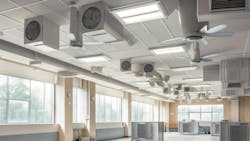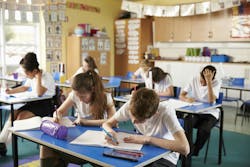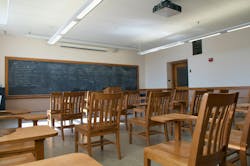by Mike Kennedy
The outbreak of Covid-19 in 2020 brought about an unprecedented shutdown of nearly every school in the nation, and over the next year, Congress responded to the sudden upheaval of the education system with an unprecedented allocation of money—$190 billion for elementary and secondary schools, and billions more for higher education institutions, non-public schools, and education relief funneled through governors.
Now, four years into a post-pandemic world, the funding that has enabled many schools to survive and recover from Covid—and the tremendous disruptions it caused—is running out. Funding provided to elementary and secondary school districts must be spent or committed to projects by Sept. 30, 2024.
As the Covid era enters a new chapter, education institutions are faced with two serious questions: Did the federal funding that gave them a badly needed lifeline achieve its purpose—providing a boost to improve the learning environment for students? And without the financial assistance from Covid relief, will they be able to maintain and enhance those improvements?
Financial assistance
Overall federal Covid relief funding, under the umbrellas of the Education Stabilization Fund, has amounted to $263 billion. Aid earmarked for K-12 schools has come to be known by the acronym ESSER—Elementary and Secondary School Emergency Relief. Federal legislation provided school districts and states with about $190 billion in three batches: $13 billion in March 2020 (ESSER I), $54 billion in December 2020 (ESSER II), and $123 billion in March 2021 (ESSER III).
In addition to ESSER, Congress earmarked $75 billion in aid for colleges and universities through the Higher Education Emergency Relief Fund (HEER); another $5.5 billion in Emergency Assistance to Non-Public Schools (EANS), and $4.3 billion awarded to governors for education relief (GEER).
The funding provided a financial boost for more than 16,000 school districts and other local educational agencies, and more than 4,500 higher education institutions.
Burbio, a company that tracks ESSER spending, categorizes the projects supported by Covid relief into five groups: Academic Intervention and Learning Loss (e.g., summer learning, early childhood education); Physical and Mental Health (Covid testing vaccinations, counseling and mentorship); Facilities and Operations (e.g., air filtration, HVAC, building repairs); Technology (e.g., mobile devices, infrastructure) and Staffing and Retention (e.g., teachers, counselors academic interventionists).
As could be expected with any massive spending program, some of the projects pursued by school districts with ESSER funds have been deemed inappropriate, even though allowed under the rules—improvements like new football fields or other athletic facilities.
As it became clear that the average student sustained academic setbacks during the pandemic, schools have used much of their Covid aid to focus greater attention on academic intervention and learning loss. For ESSER III funding, districts must spend at least 20% of the money they receive to address learning loss. To further efforts that address learning loss, the Biden administration is urging states and districts to adopt three strategies that can improve student learning.
- Increasing attendance: the rate of chronic absenteeism reached about 31% in 2021-2022 because of Covid-19, the White House says Low-cost informational interventions, like sending texts to parents about their children’s missed school, can reduce absenteeism by up to 17%. Research also shows that targeted parent and family engagement can significantly increase student attendance.
- Providing high-dosage tutoring. Well-designed and well-implemented tutoring programs can significantly accelerate student learning. high-dosage tutoring can reduce burdens on teachers and complement other school-based activities.
- Increasing summer learning and extended or afterschool learning. Close to half of school districts have invested ESSER funds in expanded summer learning, which has been shown to improve students’ math scores.
Clearing the air
The early days of the Covid-19 outbreak brought intense attention to the inadequate ventilation and substandard air quality in many of the nation’s school facilities. The disease is disseminated through airborne pathways, and the poor air quality in many education facilities created environments in which the virus was more likely to spread among students and staff.
So when the federal government began allocating billions of dollars in aid to help schools survive and recover from the effects of Covid-19, many schools took the opportunity to upgrade their heating, ventilation and cooling systems.
A November 2022 report from the U.S. Green Building Council, School Facilities Funding in the Pandemic, analyzed data from 5,004 school districts and found that air filtration/HVAC was the second-highest category for planned spending, just behind staffing/teachers/academic interventionists/guidance counselors.
“Of the 5,004 districts, nearly half elected to put some degree of funding toward the air filtration/HVAC category, with 2,450 districts planning to spend ESSER III funds on this area for a total of at least $5,567,461,246,” the Green Building Council said.
The U.S. Education Department informed education institutions that ESSER funds could be used in several ways to improve ventilation in their facilities:
- Inspection, testing, and maintenance of ventilation systems and approaches
- Purchasing portable air filtration units, such as HEPA air filters
- Purchasing MERV-13 (or higher) filters for HVAC systems and air conditioners
- Purchasing fans
- Repairing windows or doors so that they can open to let fresh air in
- Servicing or upgrading HVAC systems consistent with industry standards
- Purchasing equipment to run outdoor classes
- Purchasing carbon dioxide monitors, air flow capture hoods, and anemometers for custodians and building personnel to assess ventilation
- Paying for increased heating/cooling costs to cover the increased use of heating/cooling systems Other spending that supports inspection, testing, maintenance, repair, replacement, and upgrade projects to improve the indoor air quality in school facilities
Warning: Cliff ahead
ESSER funding has provided school districts with critical financial assistance as they embarked on a path to assess their facilities and programs, seek ways to recover from Covid-related setbacks, and make the changes needed to improve the learning environments in their schools. But in just a few months, that assistance will end, and some school systems may be looking at a precipitous fall from financial stability.
The so-called “fiscal cliff” is set to arrive after Sept. 30, 2024—the deadline in the ESSER legislation for school districts to obligate funding for Covid-related improvements (though some schools have been granted extensions). Future Ed, a think tank at Georgetown University, said that as of November 2023, schools have spent about $122 billion of ESSER funding, leaving about $68 billion still to be obligated.
Without ESSER funds to fortify their budgets, schools may find the improvements they put into place to emerge from the pandemic are short-lived or may even be reversed.
A Brookings Institution paper from researchers at the Edunomics Lab at Georgetown University depicts potentially calamitous scenarios for schools encountering the fiscal cliff.
“Many districts will need to right-size their budgets,” say the authors, Marguerite Roza and Katherine Silberstein. “This is likely to involve painful cuts...especially challenging in districts that used relief money to add staff or maintain excess capacity that they would not have been able to afford otherwise.”
For instance, in Philadelphia, ESSER funding enabled the school district to balance its budget in 2023, but without Covid aid, the district is projecting a $407 million deficit for fiscal 2025. The San Diego Unified District reported a projected $70 million deficit because of the end of ESSER combined with a state budget shortfall. The Orange County (Florida) district wants to continue initiatives such as intervention teachers and mental health counselors, but the $28 million in ESSER funds that has paid for them will no longer be available.
Prioritizing equity
The effects of the cliff will be worse for districts serving high-poverty communities, the Brookings report says. The researchers found that districts serving a high share of students in poverty appear to be spending their ESSER dollars at a slower pace than their more affluent counterparts. A slower spending pace means a district has had even more money in its 2023-24 budget, and that will lead to a larger year-to-year contraction as the cliff hits in fall 2024.
Cuts necessitated by the fiscal cliff, especially in districts that have used ESSER funds to hire more staff, also might lead to staff reductions that affect high-need students disproportionately.
“If history is any guide, with these types of staff reductions, the most vulnerable students experience the most disruption,” the Edunomics researchers say.
Some districts may hold out hope that states could increase education funding to offset the loss of ESSER money, but securing adequate funding for schools typically has been an uphill battle, even before Covid.
“Districts with high-need students depend more heavily on state funds, so any slowing in state revenue can worsen equity,” the report says.
The report urges states and school districts to make equity a priority as they address the end of ESSER funding.
"At the state level, we suggest leaders pencil out any proposed changes to revenue structures and find ways to ensure equity isn’t lost in transition," the Edunomics researchers recommend. "If states are considering new education spending, they might target it carefully to where needs are highest, e.g., to districts with the least capacity to raise local funds."
Kennedy, senior editor, can be reached at [email protected].
About the Author
Mike Kennedy
Senior Editor
Mike Kennedy has been writing about education for American School & University since 1999. He also has reported on schools and other topics for The Chicago Tribune, The Kansas City Star, The Kansas City Times and City News Bureau of Chicago. He is a graduate of Michigan State University.



